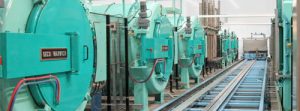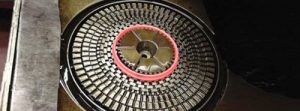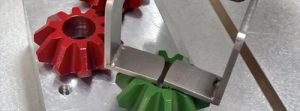
There are many books, papers, and publications that metallurgists and heat treaters rely on to assist with heat treating, material selection, failure analysis, or other daily endeavors. Certainly, the ASM Handbooks come to mind, as well as the pocket guides or booklets that steel companies put out.
One of my favorite pocket booklets, which was a little too big for a pocket, was “Crucible Steel Data for Buyers and Metallurgists” from the early 1980s. Figure 1 shows my well-worn copy.
It contains the composition for SAE, military, aeronautical, and VAR carbon and alloy steel grades. It also contains the hardenability limits, as well as charts to correlate hardenability to the material section size.

It has a section that provides potential quench and temper steel grades depending on desired hardness and part section size. In addition, it contains the usual conversion tables, critical temperatures, and properties of hot rolled and cold drawn steels. In short, it’s a treasure trove of useful information.
Another of the books I used the most during my career is “Modern Steels and Their Properties” published by Bethlehem Steel, shown in Figure 2. Bethlehem Steel was founded in 1904 and run by Charles Schwab; it was once one of America’s steel giants. Unfortunately, it declined in the latter 1900s and went out of business in 2003.

I received my copy of this book in 1970 from Professor Bob Pehlke after touring a steel mill in the Detroit area. It is the sixth edition, published in 1967. I was taking Pehlke’s graduate-level extractive metallurgy course while working on my B.S. degree at the University of Michigan.
I recall the first exam, on which I scored something like 23 percent and thought I was done for. He graded on a curve, and we found out the mean for the test was only 26 percent.
He wanted to see us reasoning and didn’t expect anyone to achieve 100 percent. We were told if you made it to the graduate level, he was not interested in flunking anyone out unless you really screwed up.

The book contains a wealth of information. It starts off with the steelmaking process and a description of each chemical element and what it does. This is followed by the chemistry of common steel grades and specifics on carburizing and full hardening heat treatments used for each grade, and then there is a short section on selection of steels.
The content then transitions into the more valuable hardness and strength data for various types of steels, such as carbon steel carburizing grades, carbon steel water and oil hardening grades, alloy steel carburizing grades, alloy steel water hardening grades, and alloy steel oil hardening grades.
Some specific examples of what readers can find include:
Shown in Figure 3 is the format for the carburized steel data. It contains the core tensile strength, yield strength, elongation, reduction of area, Brinell hardness, and Izod impact energy data. The conditions evaluated are annealed, normalized, as quenched, mock carburized and reheated, and tempered at 300°F and at 400°F.

The section sizes treated were 0.5, 1.0, 2.0 and 4.0 inches. Figures 4 and 5 show the 4620 core tensile strength data for direct quench, reheat and quench, and double reheat and quench with a 300°F and 450°F temper. The bar size heat treated was 0.565 inches and the size tested was 0.505 inches.
Figure 6 shows the format for the hardness and tensile data for oil quench and tempered steels. The bar size heat treated was 0.530 inches and the size tested was 0.505 inches.
The chart shows the tensile strength, yield, reduction of area, elongation, hardness, and Izod impact energy versus the tempering temperature from 400°F – 1,300°F.
This is valuable information when trying to determine the proper tempering temperature to obtain a specified hardness. It would have been more interesting if they had included the as-quenched mechanical properties rather than just hardness data.

Figure 7 demonstrates the 4340 tensile strength, yield, elongation, reduction of area, Brinell hardness, and Izod impact energy data for 0.5, 1.0, 2.0, and 4.0 diameter cross sections. The hardness and strength of a part after heat treatment is highly dependent on the steel hardenability, the type of quenchant used, and the size or mass of the part.
This is valuable information for the reader. The conditions shown are annealed, normalized, as quenched, and oil quench from 1,475°F and tempered at 1,000°F, 1,100°F and 1,200°F.
Also included are heat color charts, temper colors, tables on hardness versus carbon content for various quenching conditions, and diameter versus Jominy position for different quench rates.
In addition, there is a section that allows an individual to calculate Jominy hardenability based on the steel carbon content, the grain size, and the hardenability factor of each element.

This can be done manually or by using a rotary slide rule type calculator shown in Figure 8, which was included with the book and simplifies the process. Obviously, this was well before personal computers.
There was only one large mainframe on north campus using Fortran and a card reader during my college days at Michigan. Engineering students relied on slide rules and a few Wang calculators in a room in the East Engineering building. The rest of the book includes information on Jominy hardenability limits, machinability, grain size, quenching media, induction hardening, isothermal treatments, decarburization, nondestructive testing, tool steels, conversion tables, weights, and a glossary of terms.
Today’s budding metallurgists and heat treaters have no shortage of information to draw from when it comes to tracking down the proper processes, tried-and-true results, and best practices when working with steel and its many moving parts.

I believe the sixth edition of “Modern Steels and Their Properties” was likely the last and most complete version published. It is a true gem. There are used copies of this available online, and there is an older edition which is free to download. This would be an ideal book to reprint.
It would also be an ideal source for even the most tech-savvy heat treater.























